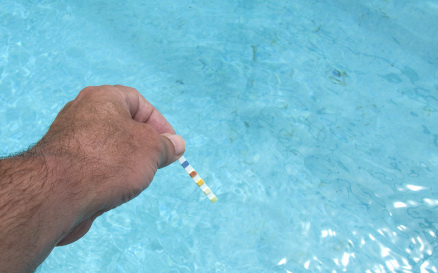So there you are, squatting by the side of your pool staring fixedly at your pool pH testing kit. And what it’s telling you is that your pool water’s pH is low. But what does that actually mean? Is it a bad thing and, if it is, what do you need to do to raise it?

Article Contents
What is pH?
pH is an abbreviation for potential hydrogen. The pH of your pool water is a measure of the percentage of hydrogen ions it contains.
The lower a pH reading, the more acidic and oxygen starved the water is. Conversely, the higher the pH reading, the more alkaline and oxygen rich it is.
pH is measured on a scale of 0-14: anything below 7 is acidic, anything over 7 is alkaline.
What Are the Effects of Low pH in the Pool?
The pH of pool water should be in a range of 7.4-7.6. Below this range, the water starts exhibiting a number of unwanted effects.
Related reading: How To Use Pool pH Testing Kit.
Low pH is Bad for Swimmers

Acidic water is corrosive. The most immediate and obvious effect is felt by swimmers: the water stings their eyes and nasal passages, and, because the acidic water strips the body of natural oils, their skin becomes dry and itchy.
Low pH is Bad for the Pool
In addition to being bad for swimmers, a low pH is bad for your pool.
Over time, the water corrodes metal surfaces and pool components such as ladders, railings, screws, pool light fixtures, as well as metal surfaces in your pump, filter system, and heater.
And it’s not just metal surfaces. Acidic water causes etching and deterioration of plaster, grout, stone, concrete, and tiling.
It will also cause vinyl-lined pool surfaces to become brittle; thus leaving them prone to tearing or cracking.
All these dissolved minerals are held in solution in your pool water. Or rather, they’re held in solution right up to the point when the water reaches saturation point. They then fall out of solution and stain your pool surfaces.
Also, the presence of dissolved metals – particularly iron, copper, and manganese – can lead to cloudy pool water.
You can read more on how to fix cloudy pool water here.
Finally, if the pH of your pool water drops much below 7, the amount of available chlorine is greatly reduced thereby leaving your pool prone to bacteria and algae.
Low pH is Bad for Your Wallet
In addition to expensive damage over time to the pool’s surfaces and fittings, low pH increases your day to day running costs.
That’s because the effectiveness of both chlorine and the chemicals required to control the pool’s total alkalinity are greatly reduced by low pH. That means you have to use more of them, thus spending more money.
What Causes Low pH?
Low pH can be caused by any number of factors.
- Local Water Source: It may be that the local water you use to fill your pool is itself low pH.
- Chemical Source: You may have added too much pH reducer having earlier seen that the pH was too high. Also, some chlorine tablets such as Tricholor have a low pH of around just 2.8. Similarly, bromine has a pH of only 4. Similarly, shocking the pool water will lower its pH.
- Rain or Ground Water Source: Rainwater can be acidic, and an especially heavy downpour can reduce your pool’s pH. Likewise groundwater can be acidic, and any flooding that enters your pool can reduce its pH.
- Organic Source: Leaves, bugs, grass cuttings, etc. will all contribute to lowering the pH.
- Human Source: Sweat, bodily oils, saliva, and urine all combine to lower the pool’s pH. That’s why it’s a good idea to check the pH after you’ve had a pool party.
How to Increase pH in the Pool
There are any number of commercial chemical products that you can use to raise the pH of your pool. Usually they have brand names that involve the word pH “Increaser”, “Up”, or “Raise”.
We recommend this pH increaser here.
Whatever their trade name, all these products are based on sodium carbonate – otherwise known as soda ash. Be aware, though: sodium carbonate isn’t the same thing as sodium bicarbonate, AKA baking soda.
Yes, you can use baking soda to raise the pH in pool, but it’s not ideal. See below.
- Make sure that the pump and filter system is running.
- Test your water in order to determine the current pH and, therefore, how much you need to raise the pH back to the desired 7.4-7.6 range.
WORD of WARNING: pool test kits and testing strips typically only measure down to a pH of 6.8. So, if your pool water’s pH is showing a reading 6.8, the actual reading may be even lower. What you need to do, first, is to bring the pH back up into the measurable range, and then fine tune from there. We recommend these Water Testing Strips and Liquid Testing Kit here. - Calculate how much sodium carbonate you need to add. As a general rule 175 grams of sodium carbonate will raise the pH of an average backyard pool of 32 m2, or approximately 42,000 litres of water, by 0.1.
Grams of Sodium Carbonate Required to Raise pH to 7.4-7.6
| pH Reading | 32 m2 Pool (approx. 42,000 litres) | Per 1000 Litres |
| 7.2-7.4 | 185 grams | 4.4 grams |
| 7.0-7.2 | 250 grams | 5.9 grams |
| 6.8-7.0 | 340 grams | 8.0 grams |
- Always follow the manufacturer’s instructions. Pool chemicals can cause serious injuries. Some sodium carbonate products need to be diluted before adding to the pool – usually because they react very rapidly with water.
- If the manufacturer’s instructions say to add the sodium carbonate in powder form, add the powder to the pool slowly. Also, add the powder at the pool’s water return jets in order to spread it around the pool efficiently. For above ground pools, also spread the powder around the water using a pole brush.
- If there’s any wind, add the powder downwind of yourself to avoid having it blow back on you. Also, get down as close the water surface as practicable.
- At first, only add around 75% of what you calculate the pool requires; make sure your filter pump is running, then wait an hour, retest the water, and add the remainder if required. The point is not to overdo it and end up adding too much – thus creating the need to lower it again.
- Retest the water for both pH and total alkalinity after 6-12 hours (make sure you run the filter pump for 4 hours during this time to circulate the water).
Can I Use Baking Soda to Raise the pH?
Yes you can. But there are a couple of drawbacks.
- Baking soda (sodium bicarbonate) is only about half as efficient at raising pH.
- Baking soda not only raises the pH, it also raises the total alkalinity. What that means in practice is that you should only use baking soda to raise pH when the total alkalinity is significantly below its desired range of 80-120 ppm. If the total alkalinity is close to or within the 80-120 ppm range, the danger is that baking soda will over-raise the total alkalinity: and then you will suddenly be two chemical levels out of whack instead of just one.
Conclusion
Learning how to raise pH in pool water isn’t too difficult when you know how. Mastering how to adjust the pH in your pool will help you to maintain a healthy, safe and clean swimming pool.
Recommended Products
| Image | Product | Features | Link |
|---|---|---|---|
 | Clorox Pool&Spa Alkalinity Increaser
| 9.7 | Check Price |
 |
| 9.5 | Check Price |
 |
| 9.1 | Check Price |
Are you interested in reducing your pool running costs? You might like to read our article 25 Ways to Reduce Your Pool Running Costs.

Related Reading:
2 Ways to Raise pH in Hot Tub (pH is Low)
How to Raise Pool pH Without Raising Alkalinity (TA)
What To Do If You Add Too Much Muriatic Acid To Pool
Does Adding Chlorine Change Pool pH Level?
What’s Best: Borax, Baking Soda, or Soda Ash for a Pool?
Should Dogs Be Allowed In Swimming Pools?


The link to the recommended product reads Sodium Hydrogen Carbonate 100%.
aka Sodium Bicarbonate.
This makes the article a little confusing.
Yes it is a little confusing as there are multiple names for Sodium Bicarbonate such as Sodium Hydrogen Carbonate, NaHCO3, Baking Soda or Bicarbonate of Soda
Awesome аrticle.
I have a 75,000 galons of water pool, open to the ambient, and PH: 6.8 Soda Ash? Chlorine 3.0
I received one complaint, about eyes, and a bit of sand in the floor.
This pool is operated by a gardner, turned pool person, without any training? As you said if it shows 6.8 it may be lower, and since it itched a bather, I need to upgrade quickly it’s ph.
I have the same issue. I take a sample to pool place. It’s free. Buy soda ash. The Ph increaser is the same thing. Whichever costs less because pool chemicals aren’t cheap. I have sand on floor too. I got a robot. Makes it easier but takes longer. Pool shock and soda ash are normally the only chemical I need. I’m going to salt water next season. Less chemicals and safer.